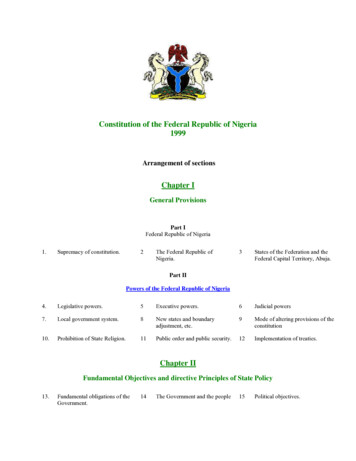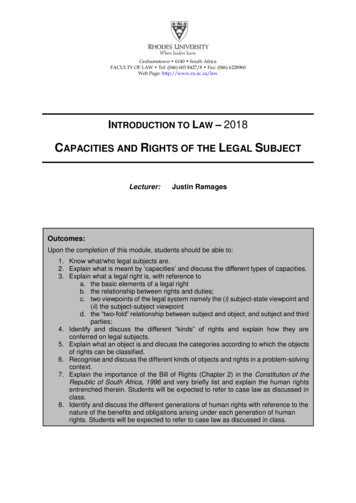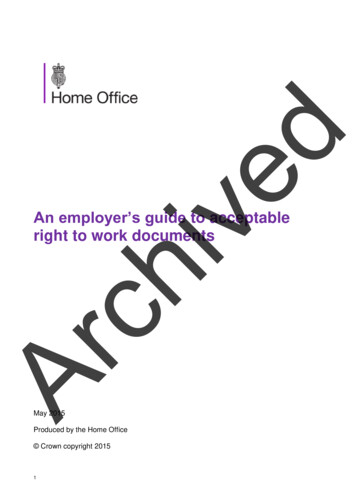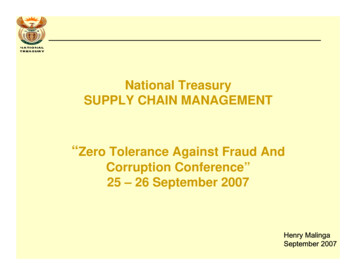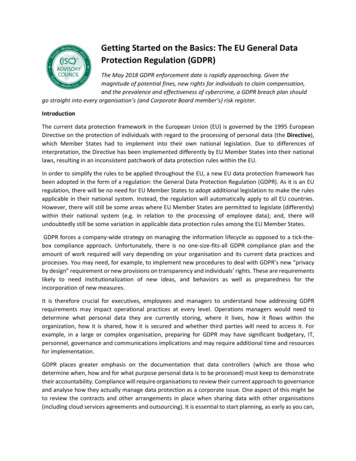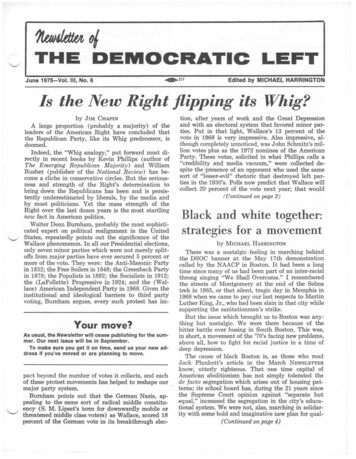
Transcription
o/THE DEMOCRATIC LEFTJune 1975-Vol. Ill, No. 6. . . . . . 217Edited by MICHAEL HARRINGTONIs th;e New Right flipping its Whig?by JIM CHAPINA large proportion (probably a majority) of theleaders of the American Right have concluded thatthe Republican Party, like its Whig predecessor, isdoomed.Indeed, the "Whig analogy," put forward most directly in recent books by Kevin Phillips (author ofThe Emerging Republican Majority) and WilliamRusher (publisher of the National Review) has become a cliche in conservative circles. But the seriousness and strength of the Right's determination tobring down the Republicans has been and is persistently underestimated by liberals, by the media andby most politicians. Yet the mass strength of theRight over the last dozen years is the most startlingnew fact in American politics.Walter Dean Burnham, probably the most sophisticated expert on political realignment in the UnitedStates, repeatedly points out the significance of theWallace phenomenon. In all our Presidential elections,only seven minor parties which were not merely splitoffs from major parties have ever secured 5 percent ormore of the vote. They were: the Anti-Masonic Partyin 1832; the Free Boilers in 1848; the Greenback Partyin 1878; the Populists in 1892; the Socialists in 1912;the (LaFollette) Progressive in 1924; and the (Wallace) American Independent Party in 1968. Given theinstitutional and ideological barriers to third partyvoting, Burnham argues, every such protest has im-Your move?As usual, the Newsletter will cease publishing for the summer. Our next issue will be in September.To make sure you get it on time, send us your new address if you've moved or are planning to move.pact beyond the number of votes it collects, and eachof these protest movements has helped to reshape ourmajor party system.Burnham points out that the German Nazis, appealing to the same sort of radical middle constituency (S. M. Lipset's term for downwardly mobile orthreatened middle class voters) as Wallace, scored 18percent of the German vote in its breakthrough elec-tion, after years of work and the Great Depressionand with an electoral system that favored minor parties. Put in that light, Wallace's 13 percent of thevote in 1968 is very impressive. Also impressive, although completely unnoticed, was John Schmitz's million votes plus as the 1972 nominee of the AmericanParty. These votes, solicited in what Phillips calls a"credibility and media vacuum,'' were collected despite the presence of an opponent who used the samesort of "lesser-evil" rhetoric that destroyed left parties in the 1930's. Polls now predict that Wallace willcollect 20 percent of the vote next year; that would(Continued on -page 2)Black and white together:strategies for a movementby MICHAEL HARRINGTONThere was a nostalgic feeling in marching behindthe DSOC banner at the May 17th demonstrationcalled by the NAACP in Boston. It had been a longtime since many of us had been part of an inter-racialthrong singing "We Shall Overcome." I rememberedthe streets of Montgomery at the end of the Selmatrek in 1965, or that silent, tragic day in Memphis in1968 when we came to pay our last respects to MartinLuther King, Jr., who had been slain in that city whilesupporting the sanitationmen's strike.But the issue which brought us to Boston was anything but nostalgic. We were there because of thebitter battle over busing in South Boston. This was,in short, a movement of the '70's facing new problems,above all, how to fight for racial justice in a time ofdeep depression.The cause of black Boston is, as those who readJack Plunkett's article in the March NEWSLETTERknow, utterly righteous. That one time capital ofAmerican abolitionism has not simply tolerated thede facto segregation which arises out of housing patterns; its school board has, during the 21 years sincethe Supreme Court opinion against "separate butequal," increased the segregation in the city's educational system. We were not, alas, marching in solidarity with some bold and imaginative new plan for qual(Continued on page 4)
New Right.(Continued from page 1)make him the all time leader for splinter party Presidential candidates and make his party the first splinterparty to collect more than one million votes in threesuccessive elections. The polls conducted by Pat Caddell, McGovern's '72 pollster, show that while only 18percent of the public considered voting for Wallace in1972, 35 percent would consider voting for him now.The number who consider Wallace unacceptable hasfallen from 62 percent of the population to 47 percent.In tandem with the change in mass opinion (or perhaps causing it) there has been a greater acceptanceof Wallace among mainstream politicians who are responding to the size of his constituency. Despite suchwell-publicized events as Ted Kennedy's visit to Alabama, the most striking shift has been among theleaders of the Republican Right. They have come torealize that more than two-thirds of those Americanswho call themselves conservatives are not in the Republican Party. Conservative politicians increasinglysee their Republican connections with establishmentliberals like Percy and J avits as an impediment toreaching the conservative masses.Like us, the New Right believes in realignment. Anadvertisement in the National Review gives us an ideaof the rhetoric of Right Realignment: it will pit acoalition of "producers" against a "new and powerfulcoalition of hon-producers comprised of a liberal verbalist elite and a semi-permanent welfare constituency, all co-existing happily in a state of mutuallysustaining symbiosis." The center of the enemy coalition, according to Phillips and Rusher, is the liberalmedia and related institutions in the "educationalindustrial complex." According to Phillips, the historyof the United States has been a series of struggles betwePn ever-changing Northeastern elites and the restof the country. In the past, he argues, the elites havebeen conservative and the masses have wanted change.But now, with an elite centered in the knowledgeindustry, the elite depends on the creation and consumption of novelty, and the masses want stability.So, mass movements of protest, once found on theLeft, rise now from the Right. And while FDR, likeother "Left" Presidents before him, found his greatest11.w;4kiwt o{THE DEMOCRATIC LE-FTMichael Harrington, EditorJack Clark, Managing EditorPeople who helped put this issue out:David Densman, Gretchen Donart, Carol Drisko, Marjorie Gellermann, Jimmy Higgins, Selma Lenihan,Donna McFarlane, Hubert Rodney, Cynthia Ward.Signed articles express the views of the author.Published ten times a year (monthly except Julyand August) by the Democratic Socialist OrganizingCommittee, 31 Union Square West, Room 1112, NewYork, N.Y. 10003.2Conservatives organize ca11cusThe right wing Governor of New Hampshireand the man who spearheaded Nixon's effort todismantle the Office of Economic Opportunity areworking together to organize a Conservative Caucus nationally.Only one of the efforts among right wing activists this year, the Caucus is stressing grass-rootsorganization and catch-all conservatism. It is actively headed up by Howard Phillips (no relationto Kevin), a founder of Young Americans forFreedom and the special Nixon appointee whoran afoul of the courts in his efforts to do awaywith anti-poverty programs. Meldrim Thomson,the conservative Governor of New Hampshire,has agreed to chair the caucus.In a recent letter to a large national mailinglist, Thomson appealed to those upset about thewhole range of social issues (busing, prayer inthe schools, crime, sexual permissiveness) andsolicited membership and contributions for theCaucus. He also outlined an ambitious programto organize the Caucus where conservatives arestrong, not in Washington, but "back in thehome town." Among other things, the Caucushopes to call together a national convention nextyear, and "if neither major political party intendsto offer a Presidential ticket committed to freeing America from the control of the socialists,the delegates may decide to propose and endorsetheir own candidates."-J.H.support in the South and his strongest opposition in theNortheast, Massachusetts has now become the "Left"state and Mississippi the strongest Nixon bastion.To Phillips, Gerald Ford resembled Millard Fillmore, the last Whig President. Just as the old Whigsfound their greatest support in the border states thatwould be divided by a new alignment, so Ford, therepresentative of the Midwest, comes from a sectionthat would be cut apart by a new sectional alignment(pitting Northeastern liberals against Southern andWestern conservatives). Like the old Whig President,Ford is left straddling the cleavage, unable to respondto the needs of the country by any dramatic actionlest he split his party without any forseeable gain.A third party of the Right poses a real threat for1976. If Reagan and the Republican Right can teamup with Wallace, combining the former's access tomoney and respectability with the latter's mass base,the new conservative party could, according to thetwo national polls, collect 23-25 percent of the vote.The party would draw evenly from all classes withinthe country and from self-identified Democrats, Republicans and IndeoendPnts. Southerners, rural residents and those with a high school education (as opposed to those with either more or less) would support this party more. Union members would support
ifln the same percentage as the rest of the population.Dean Burnham argues that: "The potential fracture lines around which a sixth party system wouldbe organized are, unlike the New Deal realignmentbut very much like those of all the preceeding ones,overwhelmingly horizontal: black against white; peripheral regions against the center; parochials againstcosmopolitans; blue collar whites against both blacksand affluent liberals; the American 'great middle,' withits strong attachment to the values of the traditionalthese terms would have as large a civil war potential. as any critical realignment in our history. A sixthparty system organized in such terms, and with theAmerican political formula, against urban cosmopoli-Capital quotes Stop. Go. Pump the gas, hit the brakes. It'sfor your car engine, and your economy.First we have recession, then inflation, now recession.Shortages, then surpluses. High interest rates, lowinterest rates. We seem to be lurching from one economic ditch to another in an accelerating way thatBritain has known ever since World War II. Theycall it "Stop-Go." Such an erratic economic climateerodes the strength of our system. Businessmen andconsumers find it difficult to plan. Production andinvestment declines. The public, confused and fearful,increases the cry for more Government control, formore wage and price controls, for :intervention. Whyis this happening? Are we now in some kind of econocmic spasm that requires a new kind of system?My answer is a strong no. We must understand thatsome kind of economic swings are desirable. Newideas and inventions come along. Wasteful products,firms and services need to be discarded, and a cycleflushes them out and restores the system. What we'vedone, though, is to slowly limit this essential flexibilityby years of increasing restrictions to protect us againstrisks, maintain profits, guarantee jobs and wages andprevent losses. But these same actions that seek toprotect us in the name of stability can actually generate instability; overcorrecting a swing in one direction can lead to even wider swings in the oppositedirection. Can we stop this? Yes, somewhat. Congressshould remove regulations that over-protect businessand labor. We should demand less drastic swings inspending and money supply, and promote productivity, not protection. Today, we have recession, unemployment and surpluses. Let's not make the mistakeof pumping the gas so hard that we wind up in theother ditch. If we do this, we shall surely stop thecapitalistic system, and f!O the other direction. Thenext boom you hear ma ' 'be the bust of capitalism. bad-C. Jackson Grayson,former chairperson ofNixon's Price StabilizationCommissiontans, intellectuals and students who have largely leftthat credo behind. Whatever the specific configuration, a political realignment organized aroundissues that would have to be bound up in its organization, would have the most sinister overtones."The effect of economic distress on the country, farfrom reviving the New Deal coalition, would, according to both Burnham and Phillips, simply speed themove toward such a realignment (as it did in Germany). Given the shallow roots of the existing partysystem in the mass electorate, its survival has beenmore the result of lack of serious challenge than ofpositive affirmation. The realignment has already begun. Class issues are being displaced by sectionalcultural issues. The Democratic Party has lost itsSouthern base and has become a party with its strongest roots in traditional Republican areas (the upperMidwest and the Northeast) . This leaves the Democrats with only about two-fifths of the electorate. Putanother way: Humphrey got 43 percent of the vote;McGovern got 37 percent; and the Harris poll showsKennedy getting 38 percent in a three way race.That doesn't mean that the right wingers have itmade. The conservatives are held together only byopposition to liberal policy goals; they can't agree ona positive program. The Right includes three incompatible groups: a hard core of middle class conservative ideologues, strongest in the Sun Belt of the military-industrial complex; a traditional middle classstrata of economic conservatives; and, another essentially working class constituency to whom conservatism means social and cultural conservatism. Theselatter two groups (both of which far outnumber theSun Belt conservatives) disagree on almost everyspecific issue.One can reach a curious conclusion that the working out of this Right realignment depends on the victory of a liberal Democrat in 1976. Just as Johnson'sactivist Presidency led to the events of 1968, a newDemocratic Administration could pave the way for aRepublican victory in-1984? But there is an encouraging fact hidden in the Harris poll. A new party ofthe Right, unlike Wallace's 1968 effort, would do bestamong the voters over 50 and worst among the votersunder 30.Without quite intending it, Phillips might get his"Bryan" realignment with the West and the Southuniting into a Populist minority but the Northeasternliberal elite winning the electoral majority. OSPECIAL OFFER18 issues of the Newsletter of the Democraitc Left:Volume One number one through Volume Two number ten; March 1973-December 1974. Bound in onevolume with Table of Contents and a special introduction by Michael Harrington.Pre-publication price: 17.50Post-publication price: 25.00Pre-publication orders accepted until July 31, 1975Limited Edition. Delivery September 15.Newsletter, 31 Union Square, Rm. 1112, NYC 100033
Boston march . .(Continued from page 1)ity integrated education. We were joining in a battleagainst the mobilized and determined forces of Northern Jim Crow.Clearly, the march was a success. It was under theleadership of Tom Atkins, the head of the BostonNAACP, and it had the support of Roy Wilkins andthe national NAACP. The youth contingent wassparked by the National Student Committee AgainstRacism (NSCAR), a broad front of students whoseorganizational energy came primanly from the Trotskyists of the Young Socialist Alliance. For all thesectarianism and other inadequacies of their politics,the latter acted, as they had in the anti-war movement, as a force for intelligent moderation.So the critical points made in what follows are notdirec d against the march, which achieved its goal offocusmg sympathetic and nationwide attention onthe Boston situation. Rather, they aim at probing howthe movement can go beyond this new beginning andspecifically, how it can simultaneously fight for minority rights and against the Depression.The Boston march differed from the great outpour-Government largesseSuppose Congress passed the following law:It is the public policy of the United States thatthe .2% of the taxpayers with incomes of morethan 100,000 a year shall receive a subsidy of 7.3 billion. The 46.9% of taxpayers who receiveless than 10,000 a year will receive 9 billion.However, this 9 billion will take the form of welfare payments, pensions for which people haveworked, and other grudgingly given and politically vulnerable payments. The subsidy for the 1.2 %will be conferred upon them primarily as recipients of unearned income and in the form of disguised giveaways. Further, the 1.2 % of the taxpayers who have incomes over 50,00 a year willbe granted a total subsidy of 13.5 billion, almostdouble that granted to the bottom 46.9 % .As part of this program, the 50,000 and upcategory will receive 73% of the subsidies forhousing rehabilitation, 44.8% of the retirementsubsidy, 88% of the advantages from state andlocal debt, 66% of the benefits conferred by theGovernment upon capital gains and 41.7% of thegain from untaxed capital gains at death.This "fantasy" (with apologies to Phillip Stemwho supplied the concept and Senator WalterMondale who provided the figures) took place inthe United States Budget during 1974; it is nowtaking place in the 1976 Budget.-M.H.4ings of the '60's in that the trade union componentin it was small and weak. It had been Martin LutherKing's genius, among many other things, to reach outto organized working people. The 1963 March onWashington was thus dedicated to the slogan of Freedom and Jobs; Walter Reuther and the UAW wereon the road at Selma-Montgomery; the State, Countyand Municipal Employees helped organize the Memphis demonstration after King's murder; and so on.In part that alliance was strained by the tensionsof the anti-war movement. When King rightly tookup the cause of peace in Vietnam, he lost support fromthe Meany wing of the AFL-CIO. Still, he and hismovement retained the backing of the anti-war unionswhich organized more than 4 million members. Andyet, there was not a massive participation from themin the Boston march. Why?There are two obvious reasons. First, this is a political period in which every union has assigned its firstpriority to the struggle for full employment andagainst the Depression. And the anti-war unions wereprecisely the ones which had taken the lead in puttingto ether that impressive Washington tum-out in April.With a scant three weeks separating the two demonstrations, it was simply not reasonable to think thatboth would receive the same emphasis from labor'smass left wing.Secondly, and more importantly, there are conflictswhich could break out between white and black workers over scarce jobs. That makes it doubly difficult tounite them on the question of racial justice. The Massachusetts AFL-CIO, for instance, has a rather goodofficial position on the school crisis in Boston and it isfor quality integrated education. But it has real problems with its conservative wing, a good number ofwhom have ethnic and personal ties with the "Southies" and other Boston whites fighting integration.Given this situation, there was an important lackin the speeches at the Boston march. Everyone saidthat "racism" was the explanation for South Boston'swhite resistance to busing. This is an individual psychological explanation that overlooks the deep socialroots of this hostility. South Boston, as Jack Plunkettpointed out in his article, is sociologically similar toblack Boston, not to the liberal suburbs. And in part,what one encounters here is a classic battle betweentwo groups at the bottom of the social pyramid. Inthe case of the South Boston Irish, the immediatefactors moving them in their reactionary direction arereinforced by an ethnic memory of the time, not toolong ago, when they were treated by Protestant Boston much as they would now treat black Boston. OnlyProtestant Boston had power; South Boston does not.It seems to me that the movement has to insistupon this point and, even while carrying out the defense of black rights against South Boston in the mostmilitant and effective manner possible, to look forfull employment demands which will link the twocommunities which are now at war with one another.I wish someone at the march had spoken out againstthe o tr geous s cial structure which incites peopleto obJectively racist behavior, and then poisons their
very minds with a racist psychology. The enemy inBoston is not the individual racist so much as it is theinstitutional structure which turns people into despairing haters who are unaware of the real sourcesof their own emotions.In Detroit, to take another example, this issue isnow posed in explosive fashion. Black and white policehave scuffled with one another and guns have beendrawn by the forces of law and order over whetherthere will be "affirmative action" in layoffs. As in everypotentially tragic situation, there is justice on bothsides. Black Detroit-black America-cannot be required to submit to an incredibly disproportionateportion of the misery so abundant in this unhappyland today (and neither can female America). Weknow that ghetto youth joblessness is now approaching 50 percent-double the national average in theworst years of the Great Depression. That will blighthundreds of thousands of lives; it will increase thenumber of junkies and the "criminal" population.But white workers did not, for the most part, createthe structures which oppress blacks and other minorities. The mass industrial unions have never had control over hiring and most craft unions lost it sometime ago. Moreover, the seniority principle is absolutely essential if the bosses are to be kept from picking off the militant unionists one by one.The blacks and browns and women are right; thewhite workers are right; and all could be on a collisioncourse which will destroy the possibility of an effectivepolitical coalition of the mass democratic Left at precisely that moment when it is most urgently needed.The Boston march could not answer that problem,of course, but it should have, yet it did not even raiseit. It is the key to black-white unity, not only in Boston, but throughout America.In the future, any movement for minority freedommust raise the demand for a guaranteed Federal rightto a job. The focus of that demand is now theHawkins-Humphrey bill which, though it has its flaws(a hostility to public employment being one of them),is the framework around which we can unite. HawkinsHumphrey, I believe, has implications which are farmore radical-in the best sense of the word-thanmany of its sponsors realize. Guaranteeing a right toa job requires massive economic planning; fundingthose jobs without inflation demands a shifting of taxburdens to the rich; but income redistribution thenmeans that the government must move to socializethat investment which has traditionally come fromthe profits of the rich.Hawkins-Humphrey, then, is an immediate demandwith a potential to lead to structural transformation,and it meets the needs of both black and white workers. But what about the interim? The Ford Administration will not give us full employment and even ifthe liberal Democrats are elected in 1976, they cannot turn the Depression around over night. How doesone deal with black-white conflicts here and now?One suggestion which originated with the IUE inNew Jersey has been noted in these pages: cut thework week to four days and pay the worker unemploy-Escaping problemsAs we all know, multinational corporationsprefer to invest in countries where labor is cheap,independent unions are non-existent, and thestrong hand of the government assures stability(with force if necessary).It hasn't taken multinational corporations toolong to discover that Communist countries fillthe bill perfectly. Recently, The Economist ofLondon (April 26, 1975) wrote about deals whichthe West German Krupp empire and the HoechstChemical Corporation had clinched with EastGermany for building plants there. As The Economist noted: "For the firms these deals are ashot in the arm-and an opportunity to escapeall the environmental, labor, and other problems"of West Germany.-STEVE KELMANment comp for the fifth day. Instead of cutting thework force by twenty percent-whether on the equallyunacceptable principles of "last-hired/ first-fired" or ofdestroying seniority-share the work but maintain theworkers' income.This idea, it must be stressed, is not a panacea. Itdoes not, for instance, apply to public employment. Adecision to cut back public services by 20 percent isnot simply a work-saving, or sharing, device; it is apolitical decision to deprive the people of the serviceto which they have a right. In the public sector, then,the demand for work sharing has a completely different meaning than in the private sector. But even inthe private sector, one must proceed with care. Itmust be a democratic decision of the union membership to re-open their contract in this area, and onewhich is pegged to a prior political delivery of changein the unemployment compensation laws.The point is that the corporate rich in Americawant to force the working people to pay the social costof the "readjustments" in the capitalist system whicha depression effects. The labor movement must beagainst that idea and :fight :first of all to place theimmediate burden on the shoulders of those best ableto bear it, i.e. the corporate rich, and secondly tocreate a genuine full employment economy. The ideaof work-sharing and supplemental unemployment compensation is a temporary technique which workersmight use to deal with pressing problems. In thislimited, but important, context, it has a possible contribution to make to the integrated movement of theblack and white working class.Under conditions of a depression, then, the fight forminority rights has to go beyond the limited spheretrue even in terms of the movement's immediate tacof civil rights; it must be socialized. This holds trueeven in terms of the movement's immediate tactics.Busing is an indispensable tool-one tool-in thestruggle for integrated, quality education. It is most5
ce tainly not the tool and, were there decent, interracial housing for all, it might not even be required.Similarly, the use of the police power is certainlynecessary in Boston-but that is an unfortunate necessity. One of the most enthusiastic responses of theday in Boston came when Maceo Dixon, the NSCARspeaker, said that if President Ford could send troopsto Cambodia in the Mayaguez crisis, he should sendthem to Boston in the school dispute.But consider that analogy for a moment. It isdeeply flawed on the face of it since Ford never shouldhave intervened as he did-precipitously, withoutpausing for a Cambodian response, and in a mood ofwounded, post-Vietnam machismo. But why, then,argue from such an indefensbile use of force in favorof a positive policy in Boston? More deeply, oneshould favor Federal troops in Boston-as we did inSelma-Montgomery, for instance--if that is the onlyway to protect the lives and rights of black childrenand their parents. But a school system cannot be runby armed troops and if that demand has to be posed,it is a sad admissi 'n of the failure of the movement tofind a non-violent and political solution to the issue.We knew in the '60's that the civil rights fightcould not be carried out in a social and economicvacuum-or worse, on the social and economic terrain of an American society which makes blacks threetimes poorer than whites. It was part of the greatnessof Martin Luther King, Jr., that he insisted on thisproposition over and over again. Now in the '70'8,under conditions of economic collapse, that is doublyand triply true. The Boston march on May 17th wasa beginning. Now we must go beyond it toward aunity of the black and white working people based ontheir common stake in the radical measures requiredto achieve a full employment economy. DSocialist notesple after Mike Harrington's April visit to North Carolina. Steve Davis has been working on recruiting downin Texas, and Houston is now in a position to requesta charter.Dinners: The Debs-Thomas dinners in New York andChicago were tremendous successes. Carl Shier reportsthat Chicago broke all previous records for attendance,with over four hundred people coming to the dinnerhonoring retired reform Alderman Leon Despres. JoeRauh kept the proceedings lively with a controversialspeech praising some aspects of the Landrum-GriffinAct. In New York, three hundred people watchedBernie Rifkin really take the honors in. In addition tothe Debs-Thomas award, he received the Walter P.Reuther Award from the UAW, and the education department of District Council 37 (AFSCME) presentedhim with a plaque. To top it all off, the College ofNew Rochelle conferred an honorary doctorate uponhim last month. The dinner itself went quite well, withstrong speeches from David Barrett, Bernie and MikeHarrington.Songbook: We now have a "Movement Songbook."The effort by Jone Johnson and Bob Breving includestraditional labor and socialist songs as well as somefeminist, anti-war and civil rights songs of more recentvintage. It's available for 2 from Contemporary Problems, Box 59422, Chicago, Ill. 60659 .Congratulations: To Debbie Meier and to Doris Kol-voord. Debbie was elected to the Community SchoolBoard in New York's District 3. And Doris was-electedchairwoman of the Democratic Party of Davenport,Iowa . . . .Growth: New surges of DSOC membership in LosAngeles, Houston and Chapel Hill, N.C. and in theOhio cities of Akron, Toledo and Youngstown. . . .Irving Howe's trip to Los Angeles last month combined well with Deena Rosenberg's energetic organizing. Our LA group is now requesting a local charter.Same for our Chapel Hill group. Gerry Cohen organized several meetings and signed up a number
sustaining symbiosis." The center of the enemy coali-tion, according to Phillips and Rusher, is the liberal media and related institutions in the "educational-industrial complex." According to Phillips, the history of the United States has been a series of struggles be-twePn ever-changing Northeastern elites and the rest of the country.



